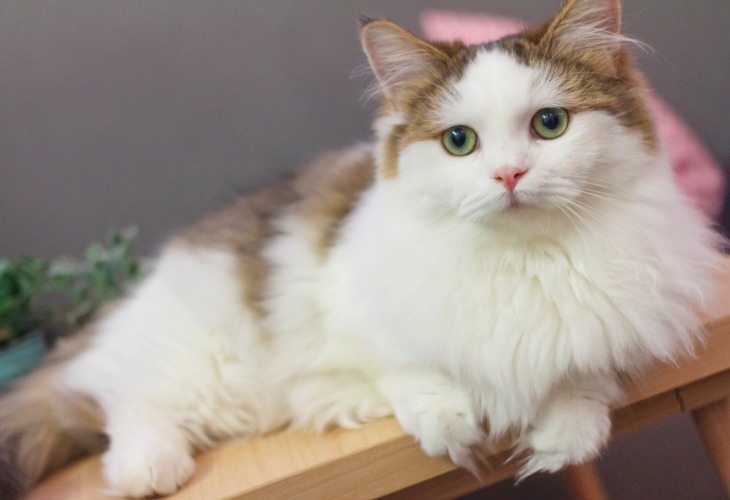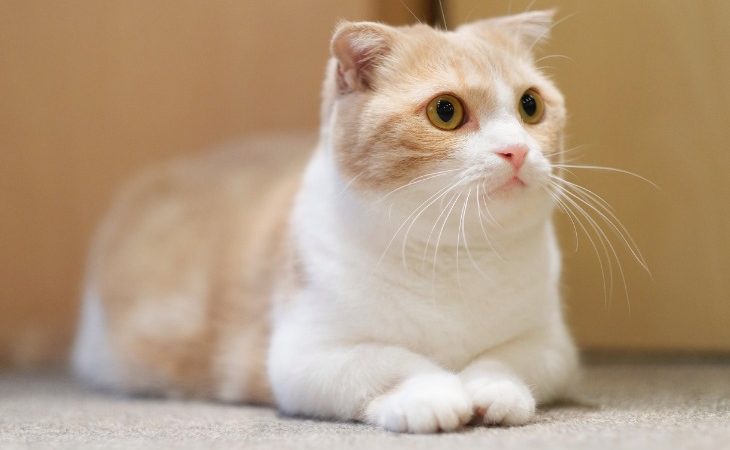Breed standard: TICA | Size: Medium | Life expectancy: 13+ years | Temperament: Friendly and affectionate | Coat: Short or medium-long | Origin: United States.
This short-legged cat breed is very friendly and is often compared to the Basset Hound or Dachshund.
The origins of the Munchkin
An unusual genetic mutation
Similar to many other cat breeds, the Munchkin is the result of a spontaneous genetic mutation that occurred in an alley cat. While most mutations in domestic felines affect their coat, this mutation affects the length of the upper leg bone. Cats with this mutation had abnormally short legs.
A very recent breed
In 1983, in Louisiana, Sandra Hochenedel, a music teacher and cat lover, found two cats with very short legs under a truck. Both were pregnant. She named one of the cats Blackberry and the other Blueberry. She kept the first one with her and found a home for the second. When Blackberry gave birth to her first litter of kittens, half of them had short legs like their mother while the other half had normal legs. Among the short-legged offspring, a male kitten named Toulouse was kept to be a breeder later.
Sandra decided to keep Blackberry, but she offered Blackberry’s son Toulouse to her friend Kay LaFrance. Blackberry and Toulouse were raised in the wild. This allowed them to breed with other types of domestic cats. As a result, this cat breed quickly spread throughout the area. The owners of Blackberry and Toulouse named the new breed Munchkin.
Yet not entirely new
Before the Munchkin, other short-legged cats had already existed in the past. The first mention of such cats dates back to the 1930s in the United Kingdom where they had lived for several generations before disappearing during the Second World War. Domestic felines with the same characteristics were also discovered in Russia in the 1950s. Later, other short-legged cats appeared in the United States, in New England and Louisiana.
However, no one had thought of developing the breed and it probably disappeared by itself. Therefore, all current short-legged cats are Munchkin cats, descendants of Blackberry and Toulouse.
A breed unrecognized by many associations
In the ’90s, the Munchkin began to attract the curiosity and affection of cat lovers. The first exhibition of the breed was held in 1991 in New York. After many negotiations with TICA (The International Cat Association), an American cat association, the breed was officially recognized in 1994. However, several major cat associations in the world still do not recognize it as a breed. It is notably the case of the Fédération Internationale Féline (FIFé), the Governing Council of the Cat Fancy (GCCF), and the Cat Fanciers’ Association (CFA). For these associations, the Munchkin is rather the result of a genetic anomaly.
It was introduced in France in 1993 by Aline and Philippe Noël. The LOOF (Livre Officiel des Origines Félines) is one of the few European feline associations to recognize the breed. From 2011 to 2019, the association had counted 332 Munchkins, including 134 shorthairs and 198 longhairs. Although the breed represents only 0.1% of the domestic feline population, it continues to appeal to cat lovers in France and around the world. In France, there are about 50 registrations per year.
The personality of the Munchkin
It is difficult to define the precise personality of this breed. The crosses made throughout the years have led to a wide variety of personalities. However, most Munchkins are described as very sociable and very endearing to children and adults. Nevertheless, some Munchkin cats are rather solitary.

The Munchkin’s qualities
The Munchkin is generally a very endearing companion, calm, and very affectionate towards its owner and to anyone who shows it attention. Its small legs are very deceiving as they do not seem to limit its mobility. They love to play, run, and can even jump.
Munchkins get along very well with children. They make great playmates. It is also a great cat for the elderly. This cat breed is very friendly with other cats and pets.
The Munchkin will not fail to entertain you with some rather comical performances. For example, it will stand on its hind legs if it is trying to get a good view of its surroundings. When it runs at full speed in front of you, it will be impossible not to laugh.
What are the downsides of the Munchkin?
The Munchkin is an apartment cat. Despite its short legs, this cat breed likes to play and climb cat trees.
Although Munchkins are friendly with other pets, it hasn’t lost its hunting instincts. It is, therefore, not pleasant for Munchkin cats to live with small animals!
Because of its small size, this cat breed can get hurt more easily than other cat breeds.
Lastly, some Munchkins may be oddly attracted to small shiny objects. They like to steal and hide these objects in places and keep them secret. Because of this, it is best to keep your jewelry away from this cat breed.
The physical characteristics of the Munchkin
General
The Munchkin has a very muscular body. Males are generally larger than females.
Head
The Munchkin’s head is triangle-shaped with rounded contours. Its muzzle is thin and well-defined, while its nose is medium-long and straight. The cheeks are well-developed. The head is proportional to the body of the animal and stronger in males than in females.
The ears are wide at the base, of medium size, but proportional to the rest of the body. They are straight, fairly spaced between them, and have a slightly rounded tip. The eyes are walnut-shaped and can be of any color regardless of the color of the coat.

Body
The Munchkin is medium, fairly thick, and well-muscled neck. The bone structure and the musculature of the body are average. This cat stands on very short legs that are 5 to 10 cm shorter than other cat breeds.
The legs are straight with a medium bone structure and good musculature. They are solid and end in round, firm paws. The arm and forearm are of equal length. The thigh and hock are also about equal in length. The hind legs are slightly higher than the front legs.
The tail is tapered and thick at the base. It is rounded at the tip and is about the same length as the rest of the body. When Munchkins move, their tails are high and straight.
Coat, color, and care
Coat
There are two varieties of Munchkin cats: short-haired and medium-long-haired Munchkin cats. Short-haired Munchkins have a short, moderately dense coat and a thin undercoat. Their coat is shiny.
Medium-long-haired Munchkins have a semi-long, silky coat with a thin undercoat.
Colors
All coat colors are allowed except amber. When it comes to the patterns, all patterns are accepted.
Care
Regular brushing is necessary to keep your cat’s coat clean and knot-free. Weekly brushing is sufficient for short-haired cats. Long-haired cats, on the other hand, should be brushed more frequently (every two or three days).
It is important to check the cleanliness of your Munchkin’s teeth every week. The eyes and ears should also be cleaned weekly with a damp cloth. It is also important to trim the claws if they become too long.
Did you know?
This unusual cat breed is named after the small people (the Munchkins) of Munchkinland in the movie The Wizard of Oz.
The Munchkin at a glance
Size: medium.
Weight: between 2 and 4 kg (around 4 and 9 lbs).
Health: Although the Munchkin is in good health, it can be prone to osteoarthritis due to the shape of its legs.
Is the Munchkin good with children? Needing to be entertained on a regular basis, the Munchkin makes a good playmate with children, even if it will quickly go elsewhere.
Is the Munchkin easy to live with? The Munchkin is an active and sociable cat that gets along well with other animals. It shows a special affection for its owner and its family.

